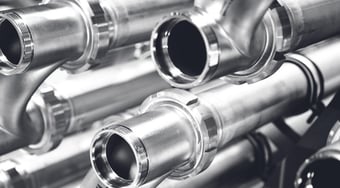To achieve a high yield, water is critical. Not only now, but also in the future. That’s where efficient use of water and sustainability comes in. There are four reasons for efficient water use: availability of water, fertilizer costs, protection of the environment and legislation. We discussed them in a previous blog.
From soil to soilless
In order to improve both yield and efficiency, you should shift from soil to soilless cultivation. Soilless cultivation means that the plant's roots are not placed in soil but in a substrate such as rockwool, cocopeat, or water. With soilless cultivation, you can reach a higher yield. It allows you to control the water and nutrient content more precisely. Also, the water distribution in substrates is more equal than in soil. Creating an identical water balance for all plants. This standardization facilitates learning and improvement.
Growing on substrates makes it easier to reach a more sterile environment and to have more effective disease control. Besides a higher yield, soilless cultivation also improves efficiency. Because it is easier to collect and reuse your drain water and therefore save on water and fertilizers. But also, by growing on substrates, you can grow on a barren terrain that would have been otherwise unsuitable for crops to grow.
Points of attention in water treatment solutions
Still, there are some points of attention. The business case depends on the type of crop. Not every crop is suitable for growing on substrate and, there is a fast influence of mistakes. We have already seen that the buffer of water and nutrients in substrates is very small. On one hand, this will improve your control of the availability of water and nutrients, but the downside is that if you don’t give the right amount, it will immediately harm your crop.
Moreover, the water’s rapid spread of pathogens in the substrate is also something to watch out for. Yes, decease control is more effective when growing on substrate, but once you have an infection it can spread quickly throughout the crop by water. Finally, low sodium water is required to recirculate the water. When the sodium level is too high, it will damage the crop.
How to tackle these issues?
So what to do with these points of attention and what water treatment solution works best for your greenhouse? When it comes to the business case, you should check the number of plants. If there are 50 or more plants per m2 in your soil, a business case for soilless cultivation will be very difficult. To tackle the fast influence of mistakes, you have to make sure you control your irrigation and fertigation. The risk of a rapid spread of pathogens by water can be handled using a good water source. For instance, it is better to use rainwater than water from a ditch or river. And you should properly disinfect your drain water before reusing it. That’s also the case with sodium. Use low sodium water or a tool to remove sodium from the water.
Do’s and don’ts in water treatment and water treatment solutions
Because technology, as developed by companies such as Ridder, makes it unnecessary to discharge drain water. The ultimate way of improving yield and efficiency though is by moving towards a fully closed irrigation cycle with zero emission to the environment. Learn more about this by reading this blog or watch out webinar-on demand for free here.
.png?width=1100&name=Landingpage%20Template%20(1).png)



